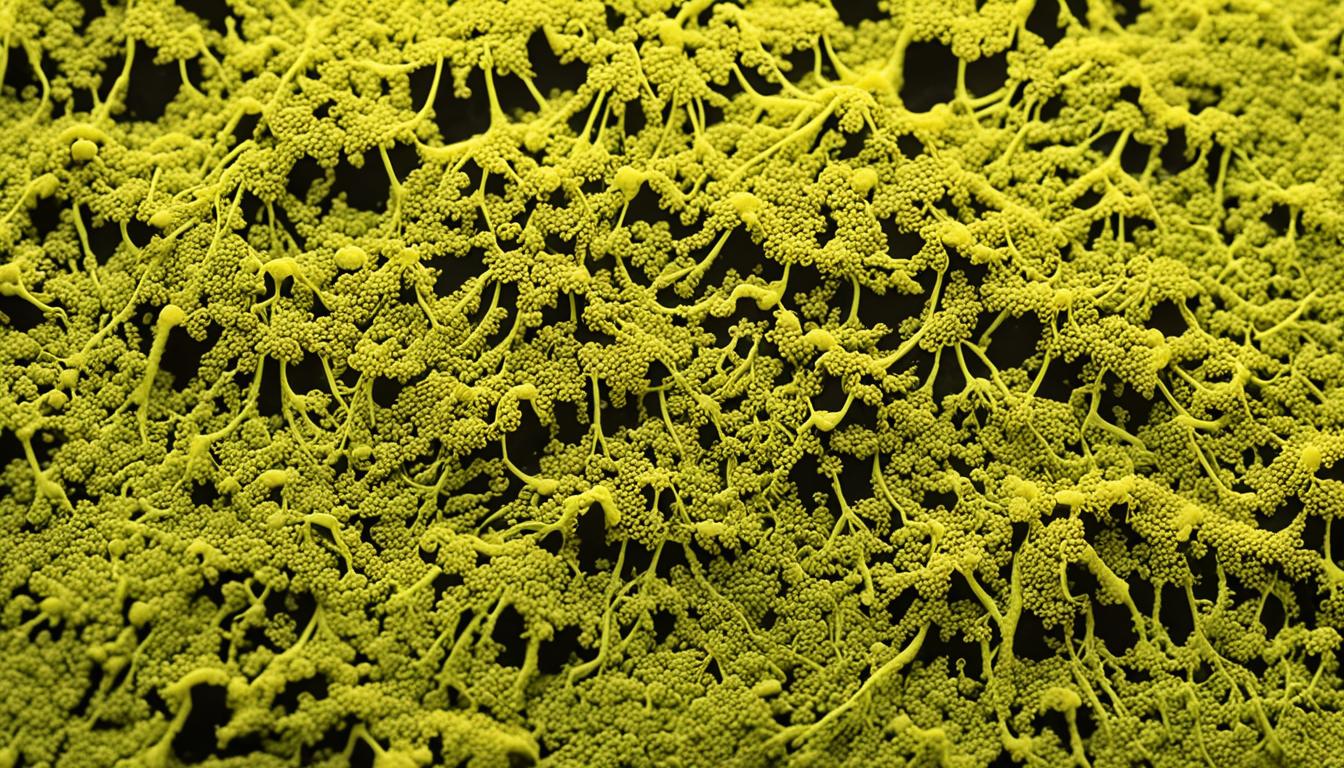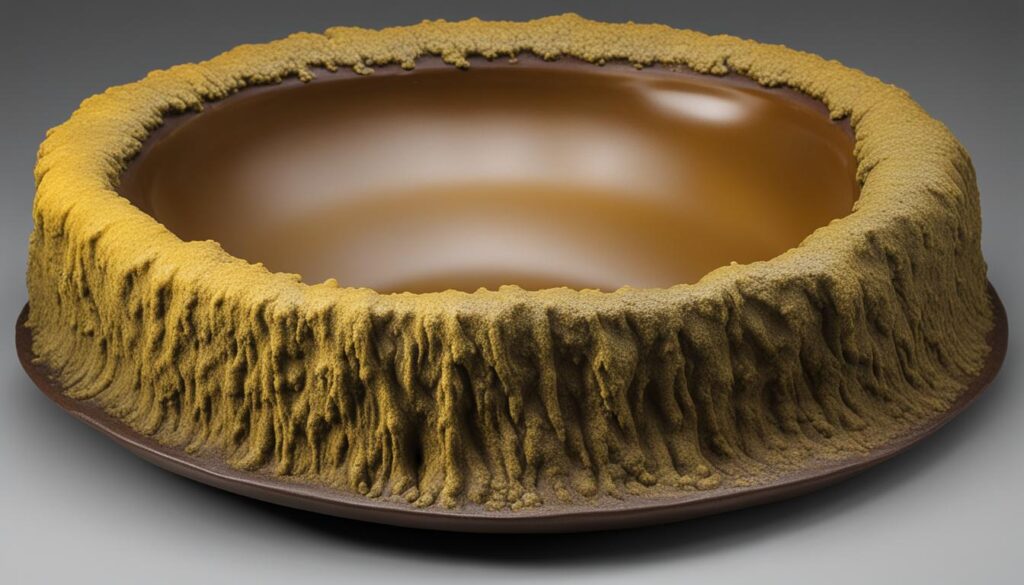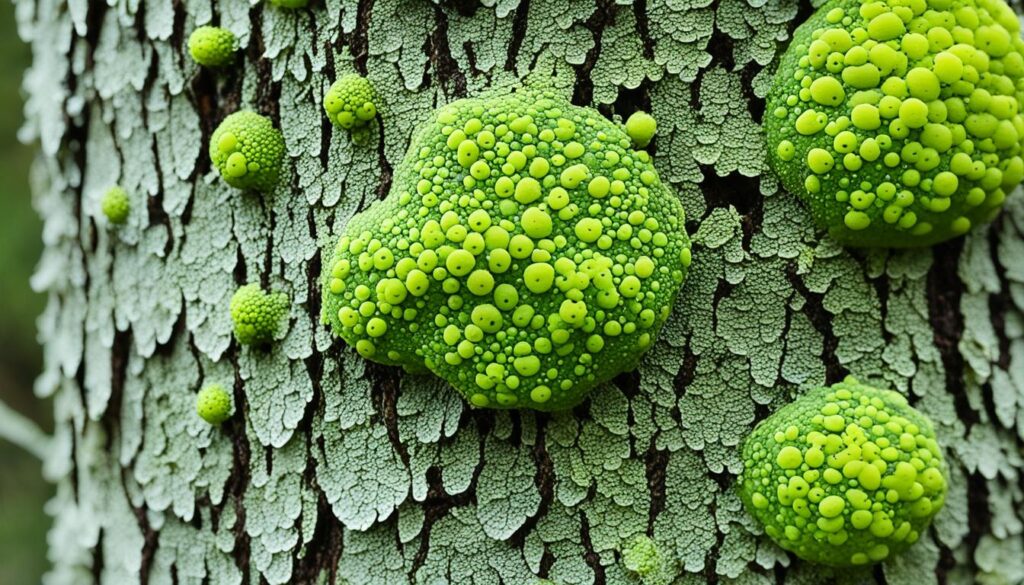
Dog Vomit Slime Mold: Facts & Control Tips
Welcome to our comprehensive guide on dog vomit slime mold. As a responsible pet owner, it’s crucial to understand the facts surrounding this fungal growth and learn effective control tips to ensure your dog’s health and the well-being of your garden. We will explore the potential impact of dog vomit slime mold on your pet’s health, discuss natural remedies, and provide veterinary advice for managing this issue.
Key Takeaways:
- Understanding the characteristics and lifecycle of dog vomit slime mold helps in identifying and managing its presence.
- Ingestion or exposure to dog vomit slime mold can lead to gastrointestinal issues and other related problems in dogs.
- Implementing natural remedies and control tips can help eliminate and prevent the recurrence of this fungal growth in your garden.
- Seeking veterinary advice is crucial if your dog shows any symptoms of illness or discomfort after encountering dog vomit slime mold.
- Maintaining a safe and beautiful environment for your dog and your outdoor space requires proactive management of dog vomit slime mold.
Understanding Dog Vomit Slime Mold
In this section, we will provide a comprehensive understanding of dog vomit slime mold. This peculiar organism, scientifically known as Fuligo septica, is a type of fungal growth that can be found in various outdoor environments, including gardens, lawns, and wooded areas. Despite its unappealing name, dog vomit slime mold is actually fascinating from a biological standpoint. Let’s delve into its characteristics, lifecycle, and the potential impact it can have on plants.
Characteristics of Dog Vomit Slime Mold
Dog vomit slime mold typically appears as a mass of gelatinous material with a bright or pale yellow color, resembling vomit or scrambled eggs. The texture can vary from slimy to foamy, and it can have a distinctive odor. This unusual appearance is the result of the mold’s unique reproductive structures.
The Lifecycle of Dog Vomit Slime Mold
Dog vomit slime mold undergoes a fascinating lifecycle that starts with spores. When conditions are favorable, these spores germinate and form tiny amoeba-like cells called plasmodia. The plasmodia merge and grow, eventually transforming into the characteristic slimy mass. This mass produces spore-bearing structures called fruiting bodies, which release spores to start the cycle anew.
Potential Impact on Plants
While dog vomit slime mold may be unsightly, it is generally harmless to plants. However, in some cases, it can cover and shade foliage, potentially reducing photosynthesis and impacting plant growth. It’s important to note that dog vomit slime mold is not parasitic and does not directly attack or feed on plants like other plant pathogens do.
Understanding the characteristics, lifecycle, and potential impact of dog vomit slime mold is crucial for identifying and managing this fungal growth effectively. In the next section, we will explore the role of plant pathology in dealing with dog vomit slime mold and discuss strategies for control and prevention.
Effects on Dog Health
When it comes to dog vomit slime mold, it’s not just the unsightly appearance that you should be concerned about. This fungal growth can have potential effects on your pet’s health, especially if they ingest or come into contact with it.
Exposure to dog vomit slime mold can lead to gastrointestinal issues in dogs, such as vomiting and diarrhea. These symptoms may occur shortly after ingestion or contact with the mold. It’s important to monitor your dog closely and seek veterinary advice if you notice any abnormal behavior or persistent symptoms.
To protect your dog from the negative effects of dog vomit slime mold, it’s crucial to take preventive measures. Avoid allowing your dog to roam freely in areas where the mold is present. Keep your garden clean by removing any decaying organic matter that may attract the mold.
If you suspect that your dog has ingested dog vomit slime mold or is experiencing health problems related to it, it’s best to consult with a veterinarian. They can provide professional advice and guidance on how to manage any potential health issues and ensure your dog’s well-being.
In addition to seeking veterinary advice, maintaining regular pet care practices is essential. This includes regular grooming, proper nutrition, and vaccinations to strengthen your dog’s immune system and overall health.
Quotes
“Exposure to dog vomit slime mold can have gastrointestinal effects on dogs, so it’s important to monitor their behavior and seek veterinary advice if needed.”
“Preventive measures, such as keeping your dog away from areas with the mold and maintaining proper pet care, are crucial in protecting your dog’s health.”
Symptoms of Dog Vomit Slime Mold Exposure
| Symptoms | Description |
|---|---|
| Vomiting | Expelling stomach contents forcefully through the mouth |
| Diarrhea | Passing loose or watery stools |
| Lethargy | Decreased energy or activity level |
| Loss of appetite | Reduced desire to eat |
| Abdominal discomfort | Pain or discomfort in the stomach area |
Identifying the symptoms of dog vomit slime mold exposure can help you take prompt action and seek appropriate veterinary care for your pet.

Controlling Dog Vomit Slime Mold
When it comes to dealing with dog vomit slime mold, effective control tips and natural remedies are essential. Not only will these measures help eliminate the mold, but they will also ensure the well-being of your furry friend and maintain the aesthetics of your outdoor space.
Preventive Measures
To keep your garden free from dog vomit slime mold, consider implementing the following preventive measures:
- Regularly inspect your garden for any signs of fungal growth.
- Remove decaying organic matter promptly, as it can attract slime molds.
- Improve the air circulation in your garden by pruning dense vegetation.
- Ensure proper drainage to prevent excessive moisture, which can promote mold growth.
- Avoid overwatering your plants, as damp conditions are favorable for slime molds.
Natural Remedies
If you spot dog vomit slime mold in your garden, you can try these natural remedies to control and eliminate it:
- Mix a solution of equal parts vinegar and water and spray it directly on the mold.
- Apply a thin layer of baking soda on the affected areas to inhibit mold growth.
- Remove the mold using a mixture of hydrogen peroxide and water, taking care to protect your hands with gloves.
While these natural remedies can be effective in controlling dog vomit slime mold, it’s important to consult a professional if the issue persists or escalates.
“By implementing preventive measures and using natural remedies, you can effectively control dog vomit slime mold and restore the beauty of your garden.”

| Control Tips for Dog Vomit Slime Mold | Natural Remedies |
|---|---|
| Regularly inspect your garden for signs of fungal growth | Mix equal parts vinegar and water and spray directly on the mold |
| Remove decaying organic matter promptly | Apply a thin layer of baking soda on the affected areas |
| Improve air circulation in your garden by pruning dense vegetation | Remove mold using a mixture of hydrogen peroxide and water |
| Ensure proper drainage to prevent excessive moisture | |
| Avoid overwatering your plants |
Conclusion
In conclusion, effectively managing dog vomit slime mold is crucial for the well-being of your beloved pet and the overall appearance of your garden. By understanding the characteristics and potential effects of this fungal growth, implementing appropriate control tips, and seeking veterinary advice when necessary, you can create a safe and beautiful environment for both your dog and your outdoor space.
When dealing with dog vomit slime mold, it’s essential to prioritize pet care. This includes regularly inspecting your garden for any signs of the fungal growth, as well as promptly removing and disposing of any affected plant material. Additionally, consider implementing preventive measures such as maintaining proper garden hygiene, providing adequate sunlight and airflow, and avoiding overwatering.
If you require professional assistance with mold assessments, prevention, or remediation, you can rely on Fix Mold Miami. Their team of experts specializes in identifying and addressing mold issues, ensuring the safety and well-being of your home and pets. For reliable mold services, contact Fix Mold Miami at 305-465-6653.




